

Structure-Based Virtual Screening (SBVS) Service - CD ComputaBio. Structure-based virtual screening (SBVS) is a computational method used in early drug discovery activities to search compound libraries for new biologically active molecules against specific drug targets.
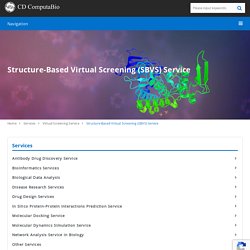
It uses the three-dimensional (3D) structure of the biological target obtained by computational models and other methods to dock a series of chemical compounds to the binding site, and selects a subset of these compounds based on the predicted binding for further biological evaluation. Figure 1. Spectrum Prediction Service - CD ComputaBio. With the deepening of quantum chemistry research and the improvement of computing software, they play an important role in the process of scientific research and chemistry teaching.
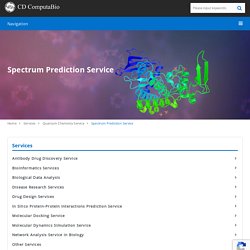
Quantum chemistry computing software can simulate and analyze the three-dimensional structure and electronic orbit of organic molecules and predict organic matter. The ultraviolet spectrum, infrared spectrum and nuclear magnetic resonance spectrum. Series Test of Cluster Service - CD ComputaBio. Figure 1.
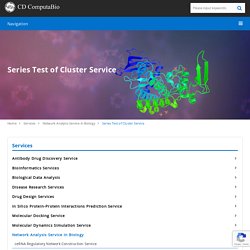
Demo result of series test of cluster service. Demo result interpretation Figure 1 shows the changes in the Profiles chart. The significant trend can be filtered with color, and the trend type of concern can also be selected. Features. Reverse Virtual Screening - CD ComputaBio. The reverse virtual screening method based on molecular docking has important application prospects in the field of drug target determination, new use of old drugs, and drug side effects/toxicology research.
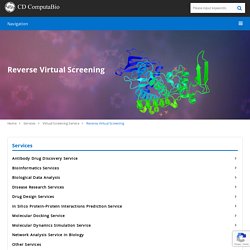
It has attracted extensive attention from researchers in the field of drug discovery. This method is the opposite of the traditional virtual screening method. For a given ligand molecule, it is necessary to select the target protein that can bind to it from the database, hence the name. The IVS method is favored by new drug developers. Statistical Data Analysis and Programming - ComputaBio. At present, massive data can be generated from structural biology projects.
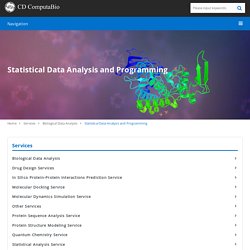
CD ComputaBio has a professional team of structural biologists who can analyze and reconstruct high-resolution macromolecular structures (and their complexes) from X-ray crystallography, NMR, and EM data. Model quality assessment and refinement are also performed to evaluate and ensure reliability. Scientific consultation is also available to interpret structural aspects and their biological significance. Overall solution. Data Visualization Service - ComputaBio. Data visualization is the best way to crunch complex data and create a flexible business intelligence system.
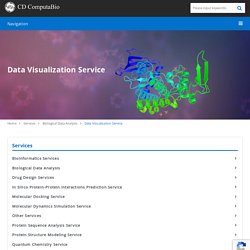
Our goal is to help businesses analyze and represent large data sets in interactive and intuitive dashboards, graphs, charts, and other visualizations. CD ComputaBio can quickly measure the industry-critical metrics using data visualization tools and deliver proactive business solutions. Overall solutions Our services. Bioinformatic Analysis-Data Preprocess and Normalization Service - ComputaBio. Our bioinformatics analysis-data preprocessing standardization services can be coupled with MS-based metabolomics.
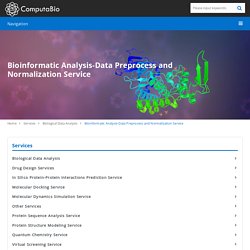
The starting point for data processing is a collection of raw data files, each file corresponding to a biological sample. The LC-MS data file is a set of sequentially recorded histograms. Each histogram represents the impact of ionized molecules on the detector in a very short time frame. The histogram consists of multiple m/z and intensity data points. Bioinformatics Data Management Service - ComputaBio. Biological data can come from all biology fields and in various formats.
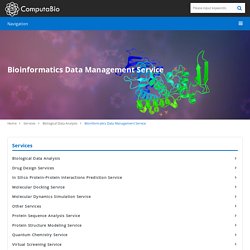
With the rapid development of various high-throughput technologies, the use of sequencing (nucleic acids and proteins), microarray technology and macromolecular structure determination methods have generated a large amount of data, especially in efforts to understand and treat human diseases. The amount of biological data is explosively increasing in size and complexity. To make full use of the data, many more complex computing technologies, robust algorithms, and statisticsal tools are needed for effective storing, searching, and retrieving data. Virtual Screening Service - ComputaBio. Virtual Screening Service Virtual Screening (VS) is a screening of active compounds based on small molecule databases.
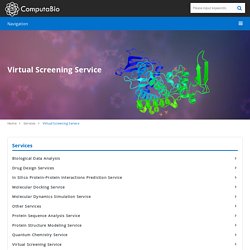
Using the molecular docking operation between small molecule compounds and drug targets, virtual screening can quickly select active compounds with druggability from tens to millions of molecules, greatly reducing the number of experimental screening compounds, shortening the research period, and reducing the cost of drug development. The positive rate of VS has been reported to be 5%-30%, and the number of successful use of VS to assist drug design is increasing annually, making VS the most promising drug development tool. ComputaBio is proud to provide the most efficient and accurate virtual screening services to our clients.
Figure 1. In Silico Protein-Protein Interactions Prediction Service - ComputaBio. In Silico Protein-Protein Interactions Prediction Service Protein-protein interaction (PPI) is a highly specific physical contact established between two or more protein molecules, which is the result of biochemical events generated by interactions, including electrostatic forces, hydrogen bonds, and Hydrophobic effect.
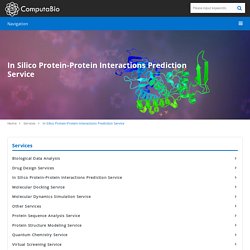
Many are physical contacts of molecular associations between chains that occur in cells or living organisms in a specific biomolecular environment. Quantum Chemistry Service - ComputaBio. Quantum Chemistry is an indispensable tool in CADD research. High-throughput computer screening of ligand binding (such as docking or QSAR) can significantly reduce the time required for compound discovery and optimization. However, these quick solutions often lack the accuracy to explore the details of the binding mechanism. Instead, we can use the quality management (QM) method to obtain a more accurate representation of the molecular system. Spectrum Prediction Service - ComputaBio. Gene Interaction Network Analysis Service - ComputaBio.
A gene interaction network is a set of genes (nodes) connected by edges representing functional relationships among these genes. These edges are named interactions, since the two given genes are thought to have either a physical interaction through their gene products, e.g., proteins, or one of the genes alters or affects the activity of other genes of interest.
Figure 1. Demo result of gene interaction network analysis. Demo result interpretation The size of the node in the above figure represents the degree of the gene, the color represents the up-and-down information, and the color or line type of the edge represents the source of interaction. Biological Data Analysis - ComputaBio. Biologists have stepped up their understanding of biological processes using various experimental methods and bioinformatics, which led to a large amount of biological and clinical data. Without proper data processing and analysis tools, researchers will be overwhelmed, especially in the absence of training or lack of knowledge about programming, statistics and modeling. Therefore, custom data analysis services are becoming increasingly important in the biological sciences and can undoubtedly help speed up the research cycle.
Figure 1. Biological data analysis. Overall solution. Biological Model Service - ComputaBio. At present, a large number of biological and clinical data do not have appropriate data processing and analysis tools. In the absence of training or lack of programming, statistical, and modeling knowledge, researchers can be at loss. Therefore, customized data analysis services are becoming increasingly important in the biological sciences, and can undoubtedly help speed up the research cycle. Overall solutions. Statistical Data Analysis and Programming - ComputaBio. Data Visualization Service - ComputaBio. Bioinformatic Analysis-Data Preprocess and Normalization Service - ComputaBio.
Bioinformatics Data Management Service - ComputaBio. Virtual Screening Service - ComputaBio. Biological Data Analysis - ComputaBio. Biological Model Service - ComputaBio. Statistical Data Analysis and Programming - ComputaBio. Data Visualization Service - ComputaBio. Bioinformatic Analysis-Data Preprocess and Normalization Service - ComputaBio. Bioinformatics Data Management Service - ComputaBio. Virtual Screening Service - ComputaBio. In Silico Protein-Protein Interactions Prediction Service - ComputaBio.